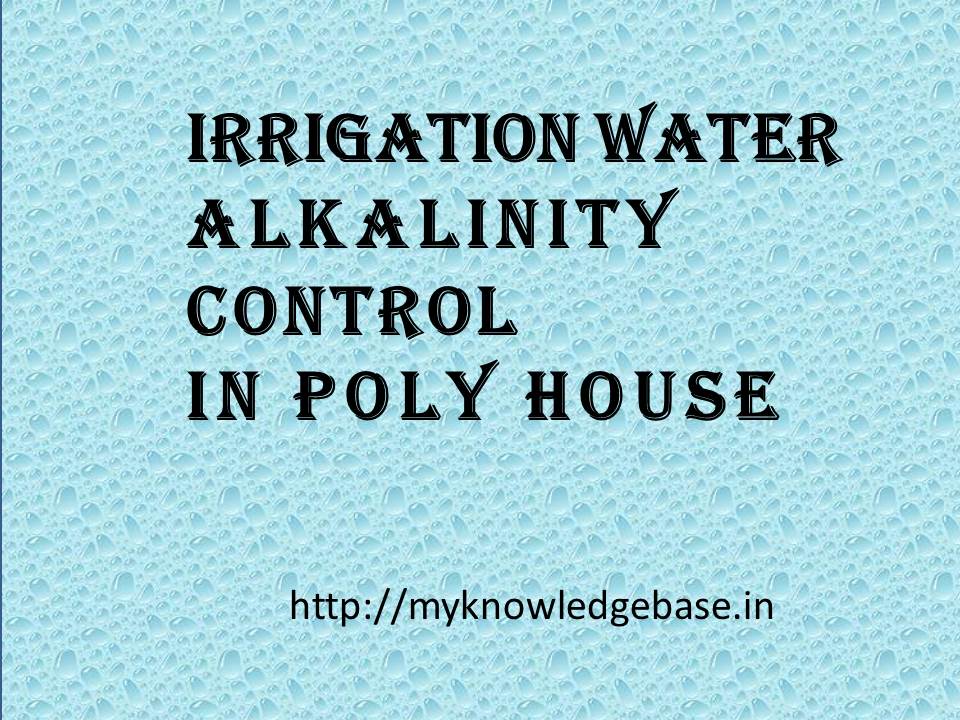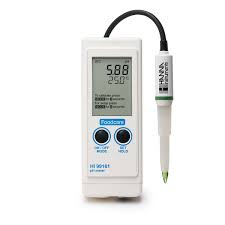Irrigation Water Alkalinity Control in Poly house
Alkalinity of water and substrate determines to a large extent whether the fertilizers Farmers so lovingly and at good cost use is actually absorbed by the plant crops. This is because fertilizers and pesticides are absorbed well by the plants when the pH of water and substrate is within a defined range. Most of crops require a pH within range of 5.5 to 6.8. Some crops require higher pH. Pesticides also require some what acidic water solution. Alkalinity affects the pH of both water and substrate. I have discussed this interconnection between fertilizers and pH in my page “Let us Talk about Fertilizers”.
What is pH
Before we can discuss Alkalinity, we must understand what is pH. This is discussed by me in my page “Control of E.C. and pH in your Soil and Water“.
According to dictionary, pH is a figure expressing the acidity or alkalinity of a solution on a logarithmic scale of 1.0 to 14.0 on which 7 is neutral, lower values are more acid and higher values more alkaline. The pH is equal to −log10 c, where c is the hydrogen ion concentration in moles per liter. Solutions with a pH less than 7 are acidic and solutions with a pH greater than 7 are alkaline. Pure water is neutral, at pH 7 (25°C), being neither an acid nor a alkaline.
pH is a dimension less quantity. Low pH allows toxic elements and compounds such as heavy metals to become mobile and “available” for uptake by aquatic plants and animals. pH of water depends upon its source, and also to seasons. In rainy season, pH tends to drop. Since the pH scale is logarithmic, a drop in the pH by 1.0 unit is a 10-fold increase in acidity. So, a water sample with a pH of 5.0 is ten times as acidic as one with a pH of 6.0. It may be noted that Alkaline and Alkalinity are two different meaning words. It is unfortunate that word Alkalinity has been coined but we are stuck with it.
What is Alkalinity
Alkalinity is a measure of water’s ability to neutralize acids. For substrate or the growing media Alkalinity is the main factor which will resist a change in pH. Alkalinity is due to presence of bicarbonates or carbonates or hydroxides of calcium and/or magnesium. The same comes from rocks and soils, salts, certain plant activities, and certain industrial wastewater discharges.
High alkalinity water often has a higher pH. If you are trying to reduce the pH of water by adding acid, more acid will be required if you are starting with high alkalinity water because the acid will react with the calcium or magnesium carbonate or other ions buffering the solution first before the pH decreases. The recommended upper limit for alkalinity for both greenhouse and nursery production is 100 mg/L (100 ppm).
Buffering capacity
Buffering capacity of water indicates how much acids are to be used to bring pH down to desired value. Buffering capacity depends on Alkalinity. Alkaline compounds in the water such as bicarbonates, carbonates, and hydroxides combine with H+ ions to make new compounds. This makes water more basic. Alkalinity affects media pH. Too low or too high pH affects intake of micro nutrients and main fertilizers. Higher the Alkalinity higher is Buffering capacity.
Effects of High Alkalinity
- Precipitates nutrients in concentrated fertilizer solutions
- Increases pH of the growing medium
- reduces the availability of micro nutrients
- reduce efficacy of pesticides and growth regulators
- can also cause foliar residue if severe
Measurement of Alkalinity
Total alkalinity is measured by collecting a water sample, and measuring the amount of acid needed to bring the sample to a pH of 4.2. At this pH all the alkaline compounds in the sample are “used up.” The result is reported as milligrams per liter (mg/l) of calcium carbonate.
We would advise Farmers avail the services of any nearby laboratory for this purpose. However, a Do-It-Yourself method is explained below:
- Collect a pH meter (which has been calibrated), graduated glass beaker, stirrer, 0.16N Sulfuric Acid.
- Collect 100 ml of water sample in the glass beaker
- Put the pH meter in the beaker and take reading of sample pH
- We assume that pH is above 6.8 value
- Add few drops of acid and stir well
- Take pH value
- Continue till pH value drops to 4.2
- Add the total ml of acid used
Farmer can perform this result on the total irrigation water required.
Methods to adding Acids to irrigation water
Several techniques have been developed for applying fertilizers through the irrigation systems and many types of injectors are available on the market.
There are two main techniques: the ordinary closed tank; and the injector pump. Both systems are operated by the system’s water pressure.
The injector pumps are mainly either Venturi type or piston pumps.
The closed tanks are always installed on a bypass line, while the piston pumps can be installed either in-line or on a bypass line. I have personally used a venturi for acidification for its simplicity and cost economy. The injection point should be ahead of the fertilizer injection point.
For further reading please see my page, “Fertigation“..
Also suggest read F&AO publication on Fertigation.


Leave a Reply